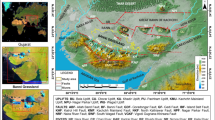Abstract
Before planning conservation strategies, decision-makers should recognize the cultural and social aspects of the people in and around any ecosystem. This might assist effective management. The needs and problems of the habitat often fail to be taken into consideration before planning forest management. Educating and encouraging the participation of local communities, especially tribal women in conservational activities could play an important role.
An attempt was made to educate the tribal women of Jambughoda Wildlife Sanctuary, Panchmahal District (Western India) about conservation of the local deciduous biodiversity. The paper narrates actions taken in the field for conserving this biodiversity, involving tribal women and children as partners of the protected areas. It might serve as an exemplary case for implementation elsewhere in the world.
Similar content being viewed by others
References
Carpenter, J.F. (1998) Internally motivated development projects: A potential tool for biodiversity conservation outside or protectedareas. Ambio 27(3), 211–6.
IUCN (1972, 1976) Survival Service Commission Red Data Book on the Endangered Mammals.IUCN, Morges, Switzerland (now Species Survival Commission, Gland), loose leaf.
McNeely, J.A. (1995) Partnerships For Conservation:An Introduction in Expanding Partnerships in Conservation (J.A. McNeely, ed.). Washington, DC: Island Press.
Oza, G.M. (1980)Editorial-Conserving world' wildlife for survival. Environmental Awareness 3(1), 1–3.
Oza, G.M. (1986) Threats to uniquewildlife through Indian habitat destruction. Environmental Conservation 13(2), 131–6.
Pandya T.M. and Oza, G.M. (1998)Bioregion Common Property Resource Management Studies. INSONA, Baroda.
WWF (1989) The Importance of Biological Diversity.World Wide Fund for Nature, Gland, Switzerland.
Author information
Authors and Affiliations
Rights and permissions
About this article
Cite this article
Kamath, S.J., Oza, P.G. Encouraging tribal women to conserve deciduous biodiversity. The Environmentalist 22, 143–148 (2002). https://doi.org/10.1023/A:1015381632529
Issue Date:
DOI: https://doi.org/10.1023/A:1015381632529




